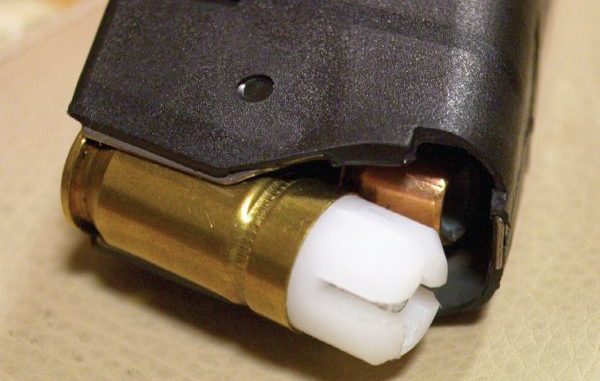
If you’ve ever set nails in concrete with an explosive shell, you’re going to be familiar with the operational concept of one of the newest and most innovative firearms safety devices on the market.
It is called the “Safety Bullet.” While it looks like a regular centerfire cartridge with a strange white plastic projectile, it is something altogether different.
The projectile in this cartridge is designed to stay in the gun, never leaving the cartridge case, and in fact plug the action and make the gun inoperable if the trigger is pulled.
Designed to give a gun owner a safe but accessible firearm when it is needed, the Safety Bullet consists of four components:
• Primer — In this case, a CCI primer — the silver dot in the center of the bottom of the cartridge case. This is the only propellant in the bullet — there is no gunpowder.
• Shell Casing —This is a standard cartridge case designed to fit exactly into a chamber or magazine, just like a regular cartridge.
• Ram — This is, for all practical purposes, an aluminum nail, with its flat head resting against the touch hole in the base of the cartridge, through which the primer fires its burst of flame into the inner chamber of the case. The power of the primer exploding strikes the flat head of the aluminum nail, and drives its tapered shaft forward into the middle of the plastic projectile, called the “expander.”
• Expander — This is a plastic “bullet” which has an “X” cut into its face. It is held in place by a crimp. When the ram drives forward, pushed by the power of the exploding primer, the ram pushes into the center of the expander, causing its tip to expand outward, filling the chamber of the gun, but not leaving the cartridge case, thus locking up the action of the gun, making it inoperable.
The manufacturer recommends placing a Safety Bullet into the chamber of a revolver immediately preceding the hammer. Thus, if the trigger is pulled, the hammer will fall on the Safety Bullet, and not on a live round.
In a semi-automatic, the manufacturer recommends loading two of the special bullets: one in the chamber, and one in the top position of the magazine.
This way, if someone pulls the trigger, the device will fire, and lock up the action.
If someone knows enough to pull back the slide on a semi-automatic, and ejects the Safety Bullet from the chamber, the slide will slam forward and load another Safety Bullet in the chamber. If the trigger is pulled then, again the action will be locked by the expander.
If the gun owner needs a live round in his chamber, he need only rack the slide twice. Both Safety Bullets will be ejected, and a live round loaded into the chamber.
In a revolver, the cylinder would have to be opened, and the safety device removed, or the cylinder rotated so the device cannot fall under the hammer.
A plastic dowel rod is included with each bullet pack, and is used to reactivate the firearm if the Safety Bullet is discharged.
The gun owner first makes sure the gun is empty by removing the magazine. Of course, you can’t open the revolver because the expander is locking the cylinder in place.
Pushing the dowel down the barrel, the gun owner taps or shoves on the dowel until the ram is shoved back down into the case, allowing the plastic bullet to shrink back to its original size, and be ejected from the chamber.
If a Safety Bullet is discharged, the gun owner can mail it back to the company, and they will reactivate it for a charge of only $3.
Because the Bureau of Alcohol, Tobacco, Firearms and Explosives has determined the Safety Bullet to not be ammunition, the product can be sent legally through the mail with no hassle.
Most common centerfire handgun rounds are available, and the manufacturer will soon have many common centerfire rifle cartridges available in the “Safety Bullet” configuration.
For the camp, for the home, for any shooter who worries about unauthorized individuals gaining access to his/her guns and firing them, either accidentally, or on purpose, the Safety Bullet is a great solution.
It gives the gun owner peace of mind his gun is safe and unable to be fired instantly, but quickly gives him (or her) access by easily getting a live round into the chamber after quickly working the action of the gun, the same as if he or she was ejecting a live round, and putting a new live round in the chamber — an action that can occur in many cases in less than a second.
For more on the Safety Bullet go to the manufacturer’s website at www.safetybullet.com.
A very instructive video on the workings of the Safety Bullet can be found on YouTube by going to www.youtube.com/embed/kL6c-30SPfg.


